Those setting off for the Camino de Santiago need to have both their body and mind well-prepared to face the challenges that arise during the days of pilgrimage.
The first thing pilgrims should do when deciding to head toward Santiago de Compostela is a complete medical check-up, including clinical exams, an ergometric test, among others, to ensure they are fit to walk for consecutive days. The tests will also help physical trainers create the best training plan considering each person’s particularities.
Ana Zimmer, personal trainer and mountaineer, recommends that pilgrims start preparing a year in advance to get to know their bodies well before beginning the Camino de Santiago. If that is not possible, she suggests a minimum of six months.
According to the trainer, physical preparation should focus on weight training; however, unlike hypertrophy training, the priority should be strengthening the ankles, knees, and hips. To avoid pain and injuries caused by the backpack’s weight, it’s also important to strengthen the core (abdominals and lower back), as well as shoulders, back, and chest.
“The focus should be on training to prevent injuries and strengthen the areas that will be most active during the walk. I emphasize mobility and strengthening of ankles and calves, which are essential for the long days of walking during the pilgrimage. Therefore, it’s not a strength workout with heavy loads. The sets and repetitions are different from hypertrophy training. We work a lot with isometric exercises, for example.”
In addition to gym equipment, Ana Zimmer highlights the efficiency of resistance bands, which can be used at the gym or at home to strengthen the ankles and hip area.
Longer hiking experiences also help evaluate how your feet behave in the boots or shoes chosen for the pilgrimage. Varying terrains, as well as training uphill and downhill, is also important. “Going up and down grassy areas, using the side of your body, works on ankle stability,” Ana reinforces. Another recommendation is to include hikes with your backpack on, gradually increasing the load to test the upper body.
Living in Barcelona, Pedro Lacaz Amaral, in addition to reinforcing his gym routine, intensified the walks he already practiced, adopting different strategies to prepare for the Camino de Santiago. “I started walking home from the office, which I used to do by bike. It’s about 10 km. On weekends, I extended the walk to about 15 km, going up and down mountains, carrying on my back the backpack with the weight I intended to take on the pilgrimage.”
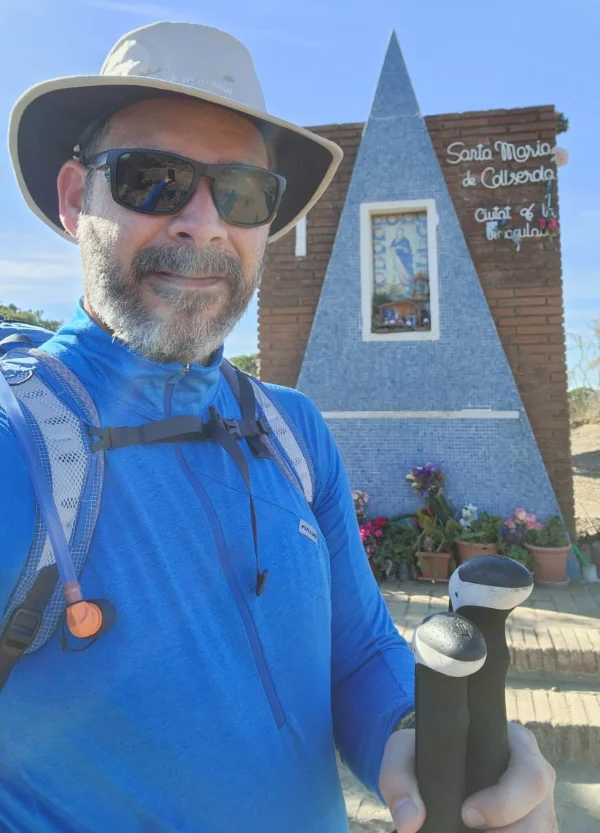
Pedro Lacaz Amaral
Having prior pilgrimage experience also helps as training and as a way to understand your body. One year before setting off for the Camino de Santiago, Marianna Sergio completed a pilgrimage in Rio Grande do Sul, the Caminhos de Caravaggio, covering 200 km through the cities of Canela, Gramado, Nova Petrópolis, Caxias do Sul, and Farroupilha. It was 11 days walking about 20 km per day. Between the two pilgrimages, she prepared physically with weight training three times a week, strengthening calves and ankles, and spinning to build strength and endurance in the lower muscles.
Techniques for Climbing the Pyrenees and O Cebreiro and Descending Zubiri and Molinaseca
Ana’s recommendation for tackling the climbs of the Pyrenees and O Cebreiro is to walk slowly, with small steps, maintaining a steady pace to avoid excessive stops to catch your breath. Another tip to save energy and avoid becoming breathless is to walk in a zigzag pattern. “When we face a steep climb on the trails, we always say: ‘Walk like an old person and arrive like new.’ There’s no point in trying to walk fast to get there sooner. You’ll just burn fuel.”
On the steep descents of Zubiri and Molinaseca, calmness and attention must be doubled. “It’s during descents that people end up injuring their ankles and knees, as well as hips. If the slope is steep, you should lean your torso slightly backward and go down slowly to avoid accidents and injuries.”
One technique recommended by Ana to make both climbs and descents easier is to walk sideways, alternating your feet in slow steps. The position and movement, according to Ana, are similar to walking with crampons in the snow. “Walking like this, the strength of your heels, glutes, and posterior muscles will help in both climbs and descents. Going up on your toes, as many people do, overloads the quadriceps, smaller muscles that fatigue faster.”
Train Walks with Trekking Poles
Trekking poles are very popular among Camino de Santiago pilgrims. In addition to saving energy, they make it easier to maintain balance by distributing the effort between upper and lower limbs. “You should take a step, hold your center of gravity, and move your arms with the motion of the poles, which will help reduce the impact not only on your knees but also on the soles of your feet—an area prone to blisters during the pilgrimage,” recommends Ana Wanke.
To Avoid Cramps, Stay Hydrated
In addition to strengthening muscles, hydration is essential to prevent cramps, as well as maintaining a balanced diet, practicing active warm-ups before physical activity, and stretching afterward. If cramps occur, perform light stretching and circular massage on the affected area. In case of lingering pain, a warm compress is recommended to relax the muscles and relieve discomfort.
How to Avoid Blisters During the Camino de Santiago
During the pilgrimage, it’s common for feet to sweat, and moisture facilitates blister formation. “During our stride, we use our heels and forefeet a lot. These are the most fragile areas that can suffer from constant effort, friction, and impact, causing pain and blisters during the walk,” explains Ana Wanke.
On his first pilgrimage, via the Central Portuguese Way, Hélio Araújo had a rather painful experience. “I had blisters from the first to the last day. I wasn’t used to walking many kilometers per day, and due to adrenaline, I walked at a fast pace, which I believe contributed to blister formation. Another mistake was not using the trekking poles I had in my backpack.”
Two years later, when crossing the French Way, Hélio, in addition to using poles every day, applied creams to his feet to prevent blisters and stopped every three hours of walking to take off his boots, change socks, and let his feet breathe. “I didn’t get a single blister on the Caminos I did afterward,” says the journalist and photographer who has completed the pilgrimage to Santiago de Compostela five times on different routes.
Physically prepared, Marianna Sergio never imagined that her feet would be a problem during the walk. In addition to researching foot care extensively, she already owned shoes for long walks, wore double-layer socks, and kept her feet moisturized. During her pilgrimage on the Caminhos de Caravaggio, her feet remained intact, but during the Camino de Santiago, blisters multiplied on the forefoot and between her toes, which Marianna attributed to the uneven terrain and long daily distances.
Marianna says that due to a tight schedule, she had not planned any rest days, which worsened her condition. While people around her walked between 21 and 24 km per day, she sometimes reached 27 km. On one particular day, she covered 32 km. “I began to notice that when I walked more than 25 km in a day, my feet suffered. I reached a very critical point where I couldn’t place both feet on the ground. On top of that, my ankles were swollen.” After receiving care at a health post, Marianna, like Hélio, started taking breaks to protect her feet.
Foot Care on the Camino de Santiago: Recommendations from Ana Wanke
At Ana Wanke Turismo e Aventura, clients take several classes with essential guidance for the Camino de Santiago pilgrimage. One of them, taught by Ana, focuses on foot care. Here are some tips:
- If you feel any discomfort in your foot, stop immediately to assess. “Sometimes a small stone can cause a blister. Also, you may start stepping incorrectly without noticing and overload the opposite leg.”
- To keep your feet dry during the walk, it’s recommended not to shower in the morning, but rather the night before.
- Hygiene: in addition to washing your feet thoroughly, wear flip-flops in the shower, as there is a high circulation of people in hostels and hotels.
- Moisturizing: suitable creams help prevent blisters. Foot hydration should start before the Camino de Santiago, as part of your daily routine. Choose a more oily composition, with 10% urea in the formula.
- Callus and blister protection gel: for sensitive feet, it’s recommended to use lubricating creams that protect the skin. “They form a film that reduces friction with socks and footwear. While at night you should apply moisturizer, in the morning it’s advisable to use the protective gel for calluses and blisters. We no longer use petroleum-based vaselines, as they clog pores.”
- Pay attention to toenails: avoid using nail polish during the pilgrimage, as it hinders assessing nail health. Remember to moisturize them as well.
- Visit a podiatrist: if you usually see a podiatrist, do so five to one week before the pilgrimage, not at the last minute. Recommendations include not over-filing the sole and trimming nails properly.
- How to prevent odor: Ana suggests not using talcum powder on feet or shoes, as it may lead to bacteria growth and hinder moisture release. She recommends applying Aztec or Lysoform deodorizer inside shoes and on insoles.
- When removing boots or shoes, take out the insoles to let them breathe, avoiding bacterial growth. Never leave socks inside footwear.
During her class, Ana also teaches pilgrims how to make anti-impact dressings to protect feet and toes, preventing blister formation.
What to Do When Blisters Appear
- It’s common for pre-blisters or small blisters to appear, which should be treated so they don’t burst. Ana recommends applying Benzoin gel, designed for drying blisters, at night. The next day, remember to protect the area to avoid worsening the situation.
- For larger blisters, if it’s necessary to pop them, use disposable, sterilized needles to prevent infections.
- If a blister bursts, the skin should be left in place, even if it’s dry, to avoid infections and pain in the affected area.
Pedro Lacaz Amaral shared on the blog his personal experience and the strategies he used to prevent blisters on his feet.
Body and Mind Integration
To have transformative experiences during the pilgrimage, it’s essential that the mind and body are aligned. Without this awareness, even if you are physically prepared and equipped with the best gear, the Camino de Santiago becomes more challenging. “The Camino is a journey. You feel pain, and your thoughts betray you. Sometimes they bring you down. At other times, even with your feet full of bandages, you feel happy,” says psychologist Luiz Henrique.
Kellyns Silva is a physical educator, founder of Kellyns Mãetiqueira, and has been working for 10 years as a mountain guide in Serra da Mantiqueira. Together with Ana Wanke, she developed a preparation program for pilgrims for the Gear Tips Pilgrim Experience, an in-person Gear Tips event focused on preparing people for the Camino de Santiago.
The goal is for them to reach what is called a state of consciousness, which reinforces self-confidence during the Camino de Santiago. “I work with a focus on feeling the body and promoting awareness of looking at each part of it as part of a whole machine.”
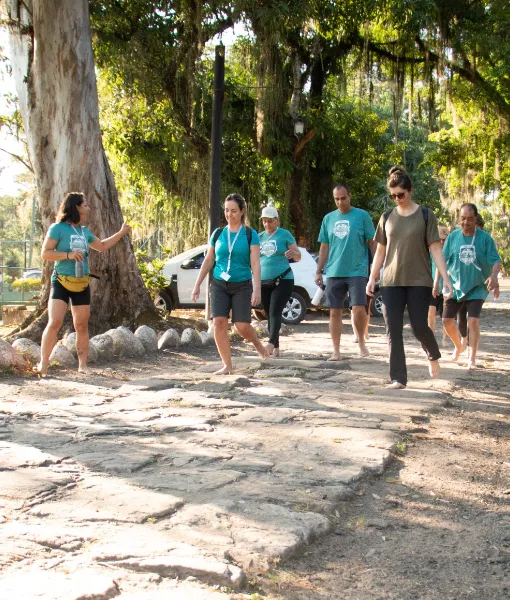
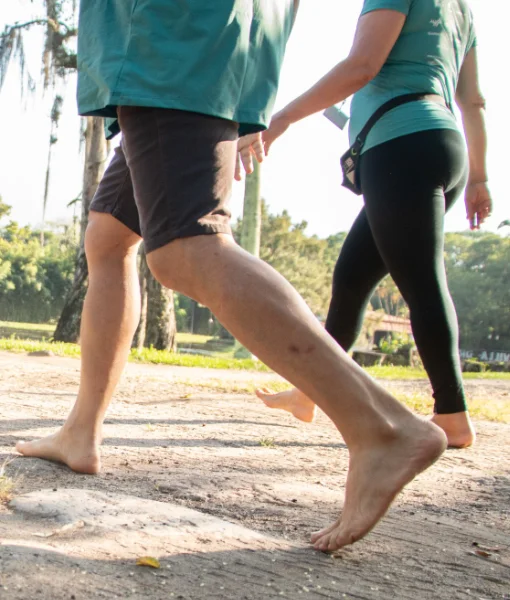
Check out the techniques used by Kellyns that can be applied during the training phase and on the pilgrimage:
Conscious stretching
Stretching exercises are essential after an intense day of walking to relieve tension in the sciatic nerve and lower back. But what Kellyns proposes goes beyond that: “On the Camino, pilgrims walk 20 to 25 km every day. During stretching, you should be aware of the area you want to work on, improving the care you give it. Five minutes of this conscious stretching, paying attention to your body, is worth much more than 30 minutes stretching absentmindedly while chatting with others.”
Conscious walking
Noticing your rhythm, the step synchronized with your breathing, your posture, and at the same time contemplating nature promotes what Kellyns calls active meditation. “It comes naturally when you start aligning your whole body. By doing this, you are already in a present state, a state of flow, of evolution, without overloading your mind. You are there, in the now.”
This state of presence described by Kellyns was remarkable for Marianna Sergio during the pilgrimage: “I walked and felt happy to notice that at that moment my legs were working, my clothes were warm or cool enough. I was present there.”
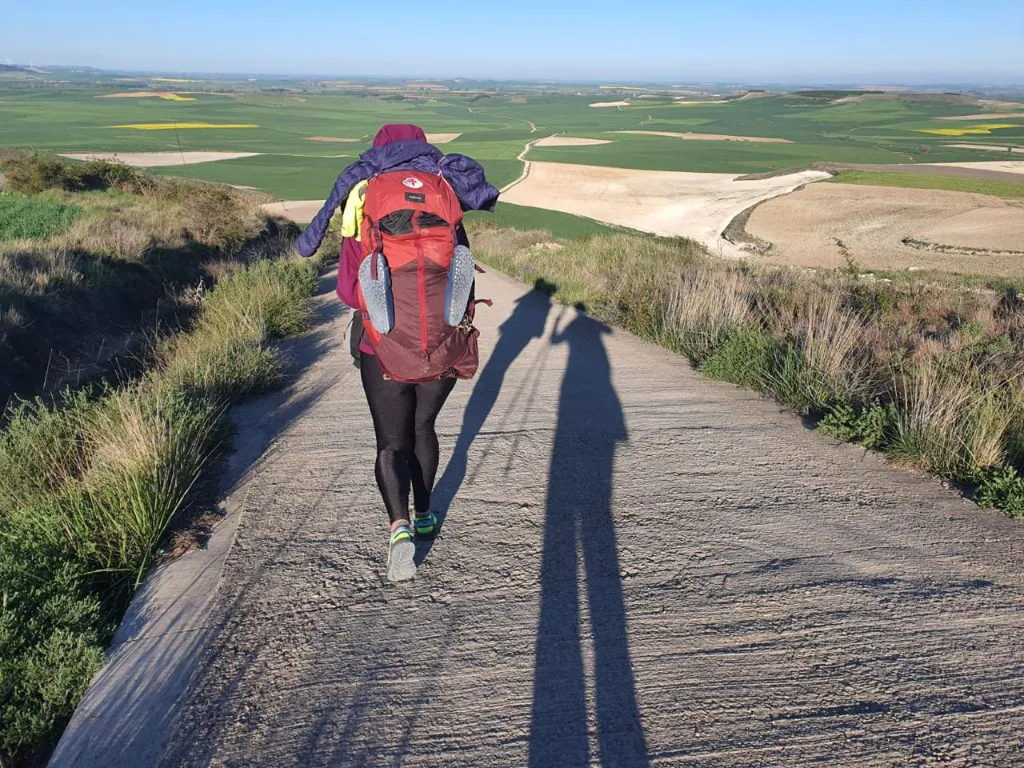
Marianna Sergio on the Camino de Santiago
Conscious breathing and hydration
The main fuels of our body are water and oxygen, and it takes awareness to breathe and hydrate effectively, which will ensure better performance during the pilgrimage. “If you breathe all the time through your mouth, there is more ventilation than oxygen transport, which can cause abdominal pain and throat dryness. Now, if you breathe consciously, filling your entire body with oxygen, your muscles will tire less, and your joints will suffer less,” explains Kellyns.
In addition to breathing, conscious hydration brings benefits to the pilgrim’s body. “You should feel the water in your mouth without pouring a large amount of liquid in, noticing its temperature, taste, and texture before swallowing slowly. By doing this, you are hydrating gradually, without needing to drink 500 ml of water all at once.”
Practice silence
Many pilgrims find in silence a refuge to deal with their thoughts, but it is not always easy to practice it when in a group. Kellyns advises taking a temporary step back to seek a deeper inner connection. “You have to step away from that energetic field to focus on yourself, so that when you get close to people again, their voices won’t matter as much if you are focused on the here and now.”
Walking in silence is a form of contemplation practiced by Hélio Araújo during the Camino de Santiago. “I like to walk in silence to hear the sound of nature. Sometimes you hear a sound of water from afar and think it’s right next to you. This sensation is provided by the silent environment, which also allows you to hear the sound of birds, your footsteps on a leaf, on stones, in mud, in water. Everything makes a sound, and you hear it very well.”
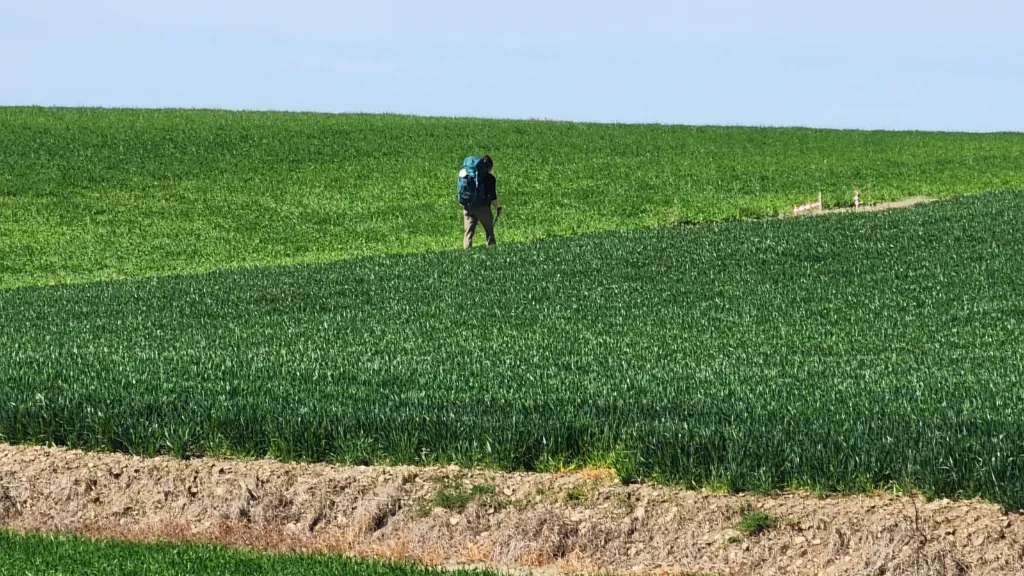
Be Open to the Transformations of the Camino de Santiago
The spiritual search and internal connections in nature are some main reasons why people from all over the world embark on the Camino de Santiago. Pausing daily life for a month of pilgrimage has the potential to transform and silence many internal noises.
“The magic of the Camino starts there: deciding to be with yourself, with your essence. It takes a little while to disconnect from home and work, but suddenly you have a click, and the social masks—whether as a boss or homemaker—start to fall. Everyone becomes more sensitive. There’s a detachment from vanity and a proposal for self-discovery, to meet other people without judgment. Everyone walks their own Camino,” says Ana Wanke.
From the first to the last day of walking, pilgrims go through deep connections. Therefore, it’s necessary to be open to dealing with feelings, which can often cause discomfort. “I’ve accompanied people who had great difficulties on the Camino precisely because they weren’t used to dealing with their own feelings and being comfortable alone,” adds Ana.
To make the most of awakening a deep state of consciousness, Kellyns suggests letting thoughts come, observing what they make you feel, and analyzing what you will do with those feelings.
Luiz Henrique says his transformation became even more noticeable at the 100 km milestone, already in Galicia: “Many people start the Camino de Santiago there. Looking at those newly arrived pilgrims, I relived what I felt at the beginning of the walk. After almost a month, you reach that point much quieter, with some voices silenced in your head. You reassess what success is and reflect on the things you need to live. At that moment, everything I was carrying in my backpack was all I needed.”
This stretch was also remarkable for Pedro Lacaz Amaral: “There, I was certain that walking the Camino de Santiago is worth it.”
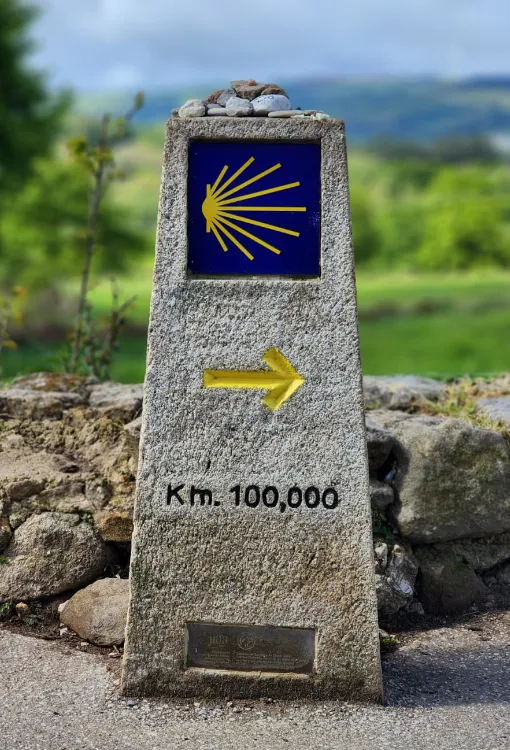
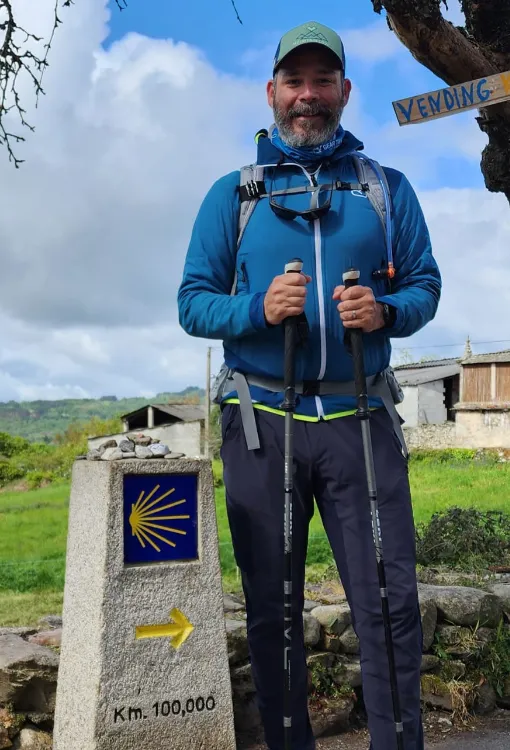
Ana Wanke – Operator that organizes hikes, trekking, camping, mountaineering, and leisure experiences in nature. Specialist in the Camino de Santiago. Ana Zimmer – Personal trainer committed to helping you achieve your goals effectively and sustainably. With years of experience in the fitness world and mountain climbing, she will guide you on your journey of physical and mental transformation through Mountain Fit. Kellyns Mãetiqueira – Company offering Experiences and Training for Body Awareness and Connection in the Mountains of the Serra da Mantiqueira region.
This post is also available in: Português (Portuguese (Brazil)) Español (Spanish)
